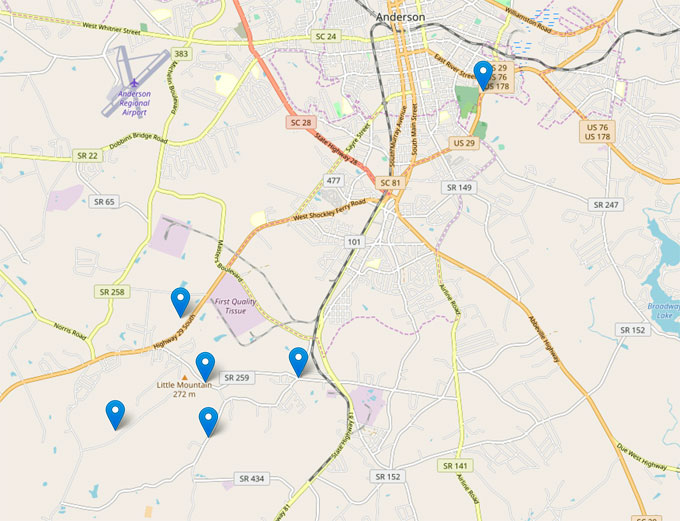
By the FBI
A man and his daughter were driving down a rural highway in Anderson County, South Carolina, on January 30, 2018, when they noticed something odd—a glowing wicker basket in the middle of the road.
The man stopped to examine the package. It exploded, causing minor burns to his leg.
Among the bomb remnants police found at the scene was a piece of paper with Arabic writing referencing Osama bin Laden, leading investigators toward a possible terrorism motive.
Local, state, and federal law enforcement collected evidence and sent the bomb components to the FBI Laboratory in Quantico, Virginia, where experts looked for fingerprints, DNA, and other clues.
The Laboratory’s experts provided on-scene investigators with a steady stream of actionable leads and information based on their findings.
The next day, after word of the incident got out, another resident called the Anderson County Sheriff’s Office to report he had seen a similar-looking device days earlier on a nearby bridge.
He did not call police at the time, but he had taken photos of it with his cell phone.
(Several bombs and other boxes containing notes pledging allegiance to the Islamic State and claims that “War has been declared” were found in part of Anderson County since January 30, according to FBI testimony in a hearing for the person of interest who was federal court Thursday in Greenville. Courtesy of WSPA 7News and YouTube. Posted on Mar 8, 2018.)
On February 4, another bomb-like object was found, placed in a black box with a letter that pledged allegiance to the Islamic State and said the community was no longer safe.
Police and the FBI then stepped up an already fast-moving investigation of what was now clearly a serial bomber.
“Every time we responded to a scene, we immediately provided evidence to the FBI Laboratory for analysis,” said Special Agent Tanya Evanina, who worked the case as part of the FBI Columbia Field Office’s Joint Terrorism Task Force (JTTF).
“We also worked with local law enforcement to canvass the area, looking at surveillance footage and talking with local businesses about the component parts.”
As investigators hunted down leads, more than 10 days went by without another incident—but the bomber wasn’t finished.

On February 15, another device was found, hidden inside a teddy bear. The teddy bear was left in a basket in the middle of the road.
“This was deliberately placed where a child or passerby could have found it,” said Special Agent Christopher Derrickson, a supervisor in the FBI Columbia JTTF.
“Fortunately, someone saw it and knew to call us.”
With the bomber still out there and becoming more brazen, the FBI and its partners continued to ramp up the investigation.
The FBI brought in profilers, analysts, bomb experts, and crisis response teams from the Bureau’s Critical Incident Response Group to South Carolina to assist in the effort.
Two more devices were found in the subsequent days: one a hoax, and one an actual bomb that bomb techs disabled before it went off. Evidence clearly linked the bombs together.
A break in the case came when local police talked to a man who said he knew someone who had been practicing building bombs in his home.

After additional investigation, the JTTF quickly closed in on the man, Wesley “Dallas” Ayers, 26, who lived very close to the site of the bombings.
After gathering enough evidence for a judge to approve a search warrant, investigators searched Ayers’ home that he shared with his girlfriend.
The evidence was overwhelming, including identical bomb components to the ones used in the devices and exact copies of the writings that had been found at the scenes.
Also among the evidence were two guns and a type of vest known to be used by suicide bombers.
“This was deliberately placed where a child or passerby could have found it. Fortunately, someone saw it and knew to call us.”
Christopher Derrickson, special agent, FBI Columbia
Ayers’ computer history showed he had self-radicalized, consuming terrorist propaganda from Anwar al-Awlaki, Osama bin Laden, and others.
In total, there were six incidents between January 24 and February 24, 2018—three hoax devices and three bombs.
The investigation was a race against time, as the FBI’s bomb experts could see the devices getting more sophisticated each time. Without the quick work to locate and arrest Ayers, the bombings could have been much worse.
“We knew based on all the evidence that he was not done deploying these devices,” Derrickson said.
“If he had not been caught, there would have been more.”
Ayers was arrested after an exhaustive month-long investigation, with the combined efforts of the Federal Bureau of Investigation; Bureau of Alcohol, Tobacco Firearms and Explosives; Anderson County Sheriff’s Office, and numerous law enforcement agencies from around the State of South Carolina.
DNA and other forensic evidence associated Ayers with the various devices.
Additionally, a search of his property produced numerous items consistent with the manufacture of the same.
(A man who is accused of having his fingerprints found on explosive devices in Anderson Co. has been indicted on federal gun and explosive charges. Courtesy of WSPA 7News and YouTube. Posted on Apr 11, 2018.)

















